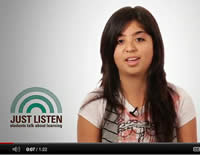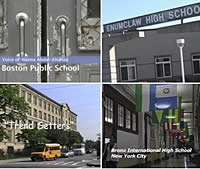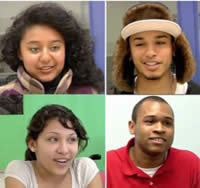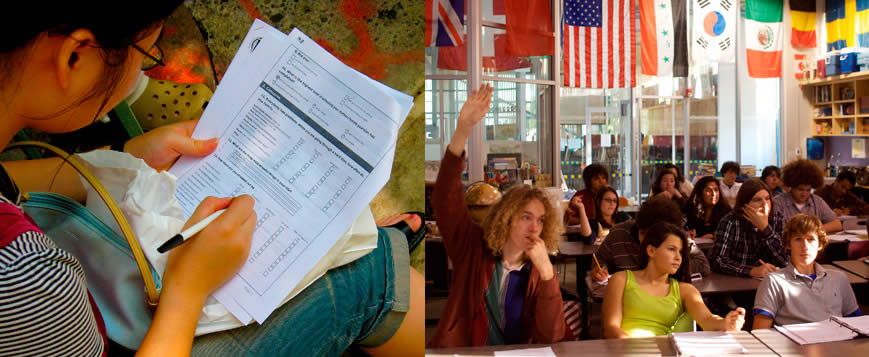
DISCUSSION STARTERS/SURVEYS (Downloadable PDFs)
| Discussion Starters/Surveys |
|---|
Who Are You? A Questionnaire for Students on the First Day of School
At WKCD, we’ve always thought that teaching and learning work best when teachers know their students well—and when students feel well known. Teachers can learn much of what they need to know about students simply by asking them. Giving out a questionnaire on the first day of a new class shows students that the teacher cares about their strengths, interests, backgrounds, and concerns about the subject area of the class—that their personal voice matters.
First Ask, Then Listen: How to Get Your Students to Help You Teach Them Better
This short manual offers a starting place for those interested in finding out what students have to say. Using the same questions that prompted the discussions leading to Fires in the Bathroom, teachers can begin for themselves the honest dialogue from which both students and adults so richly benefit. As students encounter here the teaching tools devised by the young co-authors of Fires in the Bathroom, they can critique and enlarge them based on their own experiences. And as teachers hear their own students speak their minds in a structured and respectful setting, they can begin to adapt their practice to meet their learning needs more effectively.
Students as Allies in School Reform Survey (2011 and 2004)
We began the Students as Allies project by helping students and teachers design the surveys they would administer. Together, we identifed areas where more knowledge about perceptions would help students become actors in improving their schools and teachers better supporters of student learning. The areas we chose included school climate, student-teacher relationships, teaching styles, academic expectations, safety and discipline, student voice, and improving student learning. Then we drafted a core set of questions. To these, each of the 21 student research teams added questions that were specific to their own school and circumstances, typically developed after engaging classmates in focused discussions about what needed investigating. STUDENT SURVEY (2011) | TEACHER SURVEY (2011) | SAMPLE CITY SURVEYS (2004)
Student Voice Rubric and Guide from the New York City Student Voice Collaborative
Since 2007, the Student Voice Collaborative in New York City has pushed to make student voice a force for student engagement in individuals schools and across New York City. Their "Student Voice Rubric" not only represents the hard work of a group of students who feel deeply about their education, but also some of the best thinking we've seen on the multi-layered, challenging subject of student voice—and its power to lift students and schools alike. Their "Guide to Student Voice" is detailed and complete.
Hear Us Out: Students Talk About Going to College Survey
In 2010, WKCD, in conjunction with two local education funds, trained and supported 24 youth researchers in nine high schools in two cities (Chattanooga and Seattle) to survey their peers about the help they were—or were not—getting on the path to college. Close to 5,000 students completed the student researchers’ survey and another 225 participated in focus groups and interviews. The students also surveyed counselors at their schools. The results were stunning. In addition to the reports that summarize the data student researchers collected and the focus group and interview comments, the project also produced two videos of students in both cities talking about their college paths. STUDENT SURVEY
MAJOR WKCD STUDENT VOICE PROJECTS
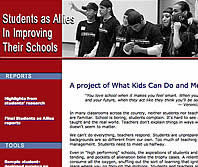 |
Students as Allies in School Reform What if teachers and students became steady allies rather than frequent adversaries in their daily classroom encounters? What would it take for students to become stakeholders not just in their own success but also in that of their teachers and schools? In 2003-2004, with support from MetLife Foundation, WKCD explored these questions with student research teams and educators in Chicago, Houston, Oakland, Philadelphia, and St. Louis. Students surveyed classmates and teachers, presented their findings at public forums, and shaped recommendations for change. We've updated the survey and supporting materials for 2011 and invite, again, teachers and students in schoools nationwide to take up our call to make students allies in school reform. |
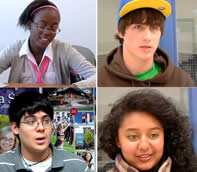 |
Hear Us Out: Students Talk About Going to College In 2010, WKCD, in conjunction with two local education funds, trained and supported 24 youth researchers in nine high schools in two cities (Chattanooga and Seattle) to survey their peers about the help they were—or were not—getting on the path to college. Close to 5,000 students completed the student researchers’ survey and another 225 participated in focus groups and interviews. The students also surveyed counselors at their schools. The results were stunning. In addition to the reports that summarize the data student researchers collected and the focus group and interview comments, the project also produced two videos of students in both cities talking about their college paths. |
 |
Inside Out: How a School Turns Itself Around |
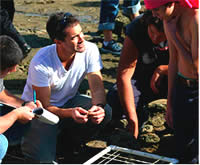 |
From 2003 – 2006, WKCD provided competitive grants to high school students nationwide, inviting them to tackle important school and community issues. With support from the Bill & Melinda Gates Foundation, WKCD distributed $200,000 in funds to 52 schools in 17 states. Here we provide a rich archive of this initiative. Student Research for Action sends several critical messages: that complex problem solving, independent judgment, and teamwork merit a place in every high school's curriculum; that what happens inside a school's walls should connect to the world outside; that young people can reflect, analyze, and create new knowledge with public benefit. |
"FIRES" SERIES AND NEXT GENERATION PRESS BOOKS
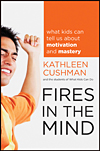 |
Fires in the Mind: What Kids Can Tell Us About Motivation and Mastery (Jossey-Bass, 2010) by Kathleen Cushman and the students of What Kids Can Do What does it take for young people to get really good at something? Teenagers from diverse backgrounds explore that game-changing question in Fires in the Mind. As they describe what fuels (or quenches) their interest and effort, they offer exciting new perspectives on why students choose to engage and persist with challenging work. WKCD writer Kathleen Cushman—whose landmark book Fires in the Bathroom brought youth voices to the national stage—here asks adolescents and their teachers to think more deeply about how we develop mastery, both in and out of school. |
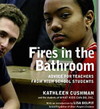 |
Fires in the Bathroom: Advice for Teachers from High School Students (The New Press, 2003) by Kathleen Cushman and the students of What Kids Can Do, Inc. In ten practical chapters from “Creating a Culture of Success” to “When Things Go Wrong,” students from across the country give their unvarnished advice on how they can be engaged, motivated, and challenged. Starting with how to build mutual understanding and respect, they tackle crucial issues of classroom behavior, group work, language difficulties, and homework, offering insight on ways to improve classroom life and relationships between teachers and students. “Turns the tables on adults.” – The New York Times; “A torrent of sensible, honest observations…If ever there we an authentic plea to make our schools human, this is it.” – Theodore Sizer |
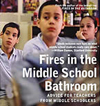 |
Fires in the Middle School Bathroom: Advice for Teachers from Middle Schoolers (The New Press, 2008) by Kathleen Cushman and Laura Rogers and the students of What Kids Can Do, Inc. What do middle schoolers wish teachers knew about them and how they best learn? This sequel to Fires in the Bathroom: Advice for Teachers form High School Students provides a much-needed window into the world of early alliance. Diverse student voices offer teachers insight into how their best practices actually play out as students change and develop, day by day, in the middle grades classroom. “We’re starting to turn into adults, so we’re not really sure what’s expects of us.” – Geoffrey; “The science teacher kept me after school. I thought it was for a bad reason, but he just wanted to get me more involved.” - Kenson |
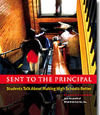 |
Sent to the Principal: Students Talk About Making High School Better (Next Generation Press, August 2005) by Kathleen Cushman and the students of What Kids Can Do We often think of adults as investing their time, ideas, and money in making schools better. If we took students equally seriously as investors, we might realize greater rewards: increased motivation, better communication, a more welcoming environment, and improved learning outcomes. How can school leaders make students allies in improving their schools? In this book, students offer some compelling answers. |
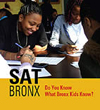 |
SAT BRONX: DO You Know What Bronx Kids Know? (Next Generation Press, May 2008) by students from Bronx Leadership Academy 2, BLA2 teachers Shannon O’Grady and Kristin Ferrales, and Kathleen Cushman What do inner-city teenagers know that the rest of us may not? What can they do that others might find daunting? What can we all learn, from thinking through the issues that confront urban youth? SAT Bronx aims to find out, by framing the words and experiences of fourteen Bronx high school students in the form of standardized test passages. To answer its multiple-choice questions (co-constructed with two of the students’ teachers and with Kathleen Cushman of What Kids Can Do), one must analyze complex matters of culture, language, behavior, even governmental policy. Taking SAT Bronx opens important conversations about multiculturalism equity, and the assumptions that underlie our thinking about urban youth. |
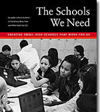 |
The Schools We Need: Creating Small High Schools That Work For Us (PDF) (May 2003) What’s so different about a small high school, compared to a large one? When school leaders decide to create more small schools in their district, how do students experience the change in their everyday routines, as well as in their sense of power and possibility? In this publication—a joint effort of WKCD, the Bronx New Century High Schools, and the Carnegie Corporation—two dozen students in Bronx, NY talk about their experiences planning and attending small schools and breaking down large high schools. |
JUST LISTEN CLIPS AND OTHER VIDEO
Just Listen: Students Talk About Learning (200 plus, 30-60 sec. video clips) "I wanna see how much my teachers are actually interested in what they want from me, like what . . . what extent would they like want me to go to, or even surpass. What do they want to see me do?" — Rashaun, 17 How do young people really experience their own learning? It’s easy for educators to make assumptions—but often we can find more authentic answers by listening closely to what students say. In WKCD’s “Just Listen” video clips, high school students speak directly about teaching and learning. Averaging one minute in length, they convey kids’ thinking in a way that’s easy to share and talk about with others. Too often, the general public perceives adolescents as apathetic and even anti-school, taking little or no interest in their own education. These videos—more than 200 in all—create a different picture: they reveal that kids care about learning and appreciate adult guidance. |
School As Subject: Four Student Documentaries about School Equality, Redesign, and College Access “Education is not the filling of a pail, but the lighting of a fire.” – William Butler Yeats For three years, WKCD supported student video projects as part of our Student Research for Action program. Video offers students an exceptional tool for asking their own questions, making their own observations, telling their own stories—and sharing them publicly. Over 10 groups of students produced videos as part of research. In the four films shown here, students turn their lens on a subject close at hand: school. Students at Brighton High School document stark inequalities between urban and suburban schools in Boston. In Enumclaw, Washington and Bronx, New York, students share the struggles that come with breaking large high schools into smaller schools. At another Bronx high school, Bronx International, immigrant students examine the obstacles in their path to college. |
Hear Us Out: Seattle Students Talk About the Path to College “One thing I always told myself was that I don't have to be the tail. I got to be the head. I know education is power.” – Seattle Student This video is part of the "Hear Us Out" project, a collaboration between WKCD (What Kids Can Do) and Seattle's Alliance for Education, with support from Lumina Foundation for Education. "Hear Us Out" student researchers conducted 9 focus groups with classmates in 5 Seattle high schools. Roughly 100 students participated in these 45 – 60 minute discussions; 30 completed individual interviews as well. Student researchers worked hard to engage a mix of students with regard to grade level, race/ethnicity, gender, and college plans. They asked: What motivates you with regard to going to college? Who has influenced you most and how? What weighs you down? What obstacles stand in your path? What are your schools doing that helps you toward college? What might your teachers and counselors do differently? What roles do mentors and special programs outside school play? What special challenges do students face who are the first in their family to attend college? What advice do you have for freshmen following in your footsteps? |
